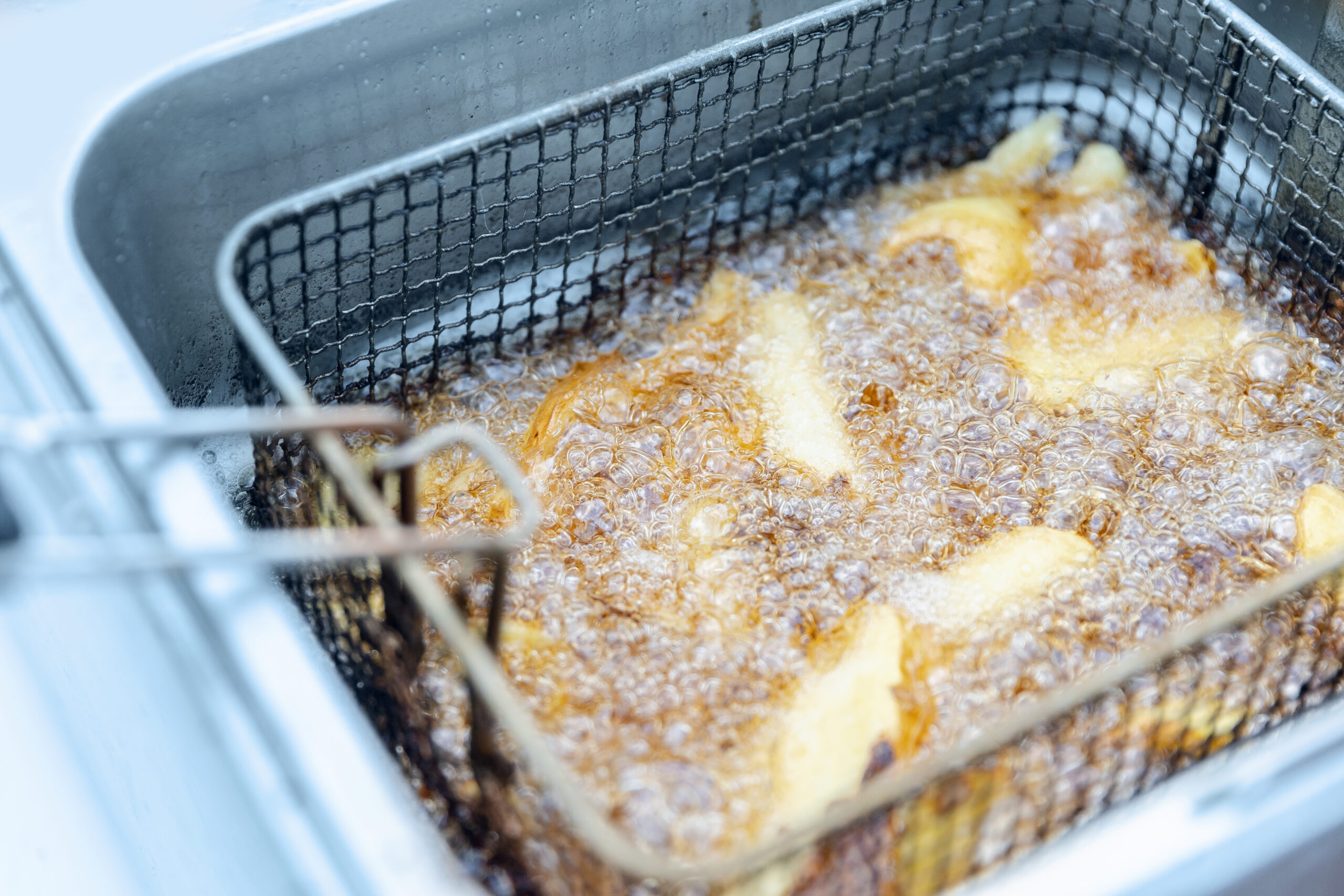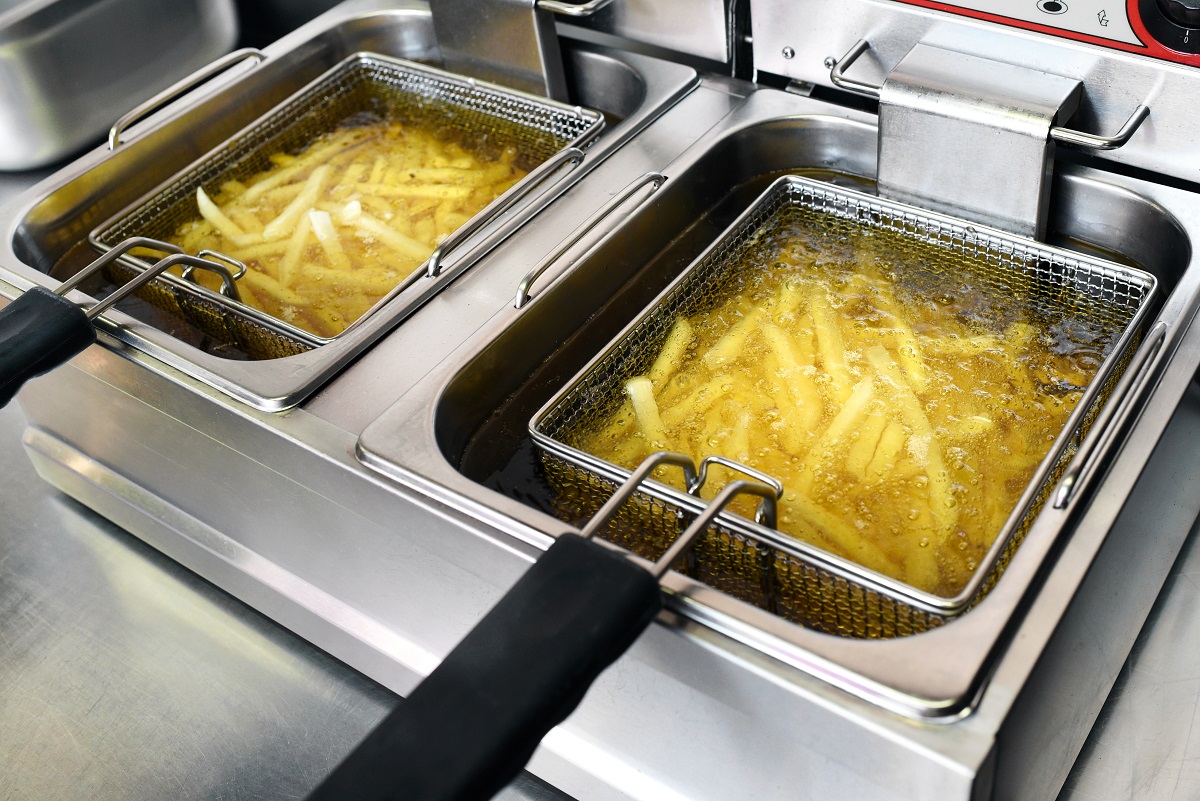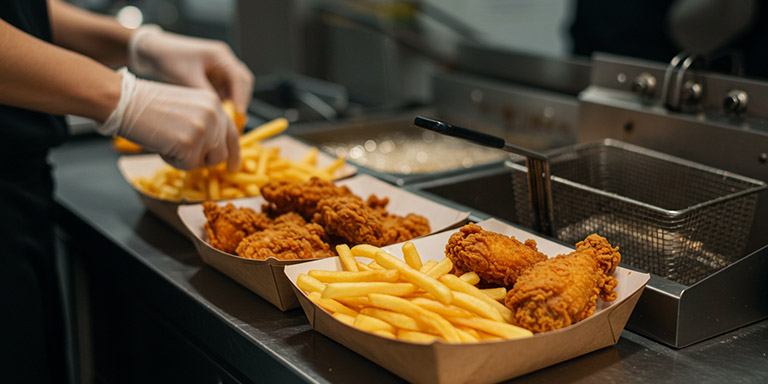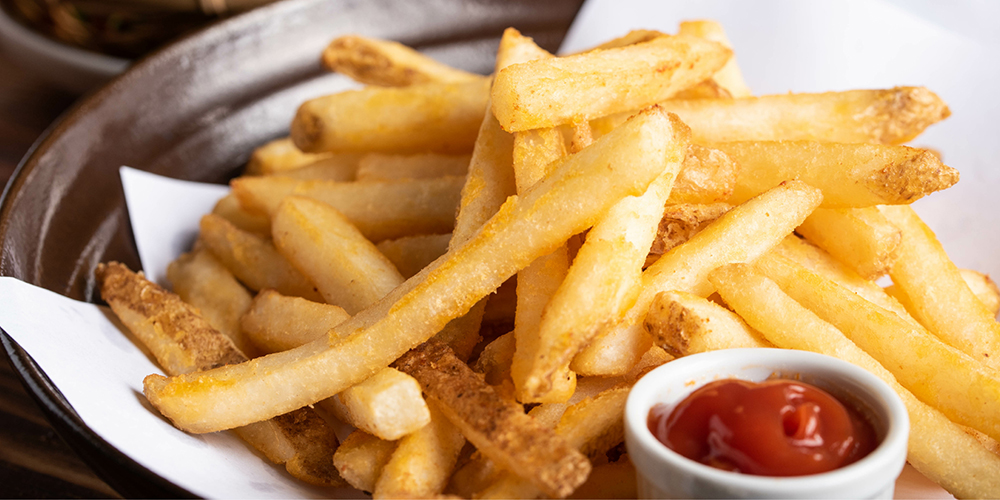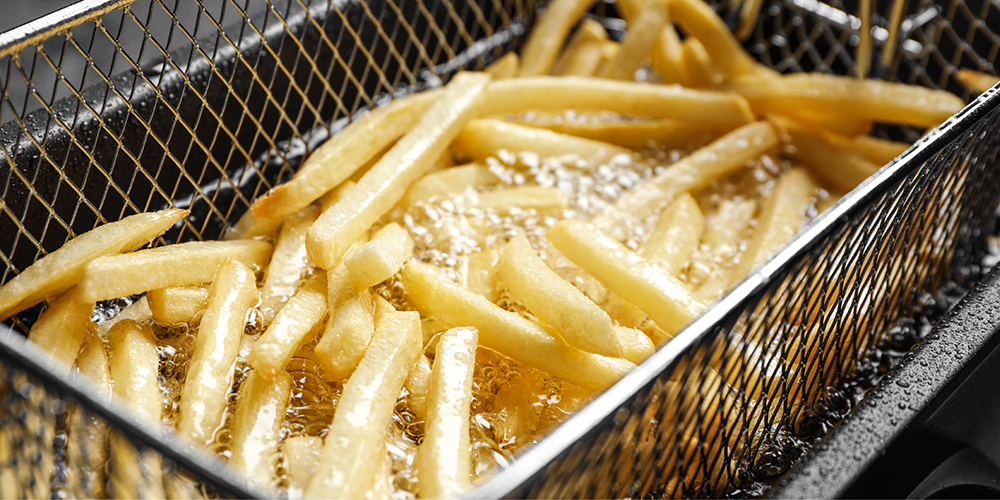Few things are as satisfying as biting into a crunchy, crispy, deep-fried food. A golden French fry, a juicy piece of Korean fried chicken, a delicious fish fried whole… this is what dreams are made of.
Of course, none of these mouth-watering foods would exist without the fryer oil that cooks them. In other words, fryer oil is a restaurant kitchen essential.
But which fryer oil should you use? Your choice can impact the taste of your food and your restaurant’s bottom line. Because choosing a fryer oil is an important decision, we’ve put together this guide. Or, take a peek at our guide to types of cooking oils here.
What to Look for in a Fryer Oil
When you’re shopping for a go-to fryer oil for your restaurant, there are a handful of factors to consider. In general, you’re looking for an oil that has:
- A high heat stability – Oils can break down or oxidize when heated extensively, so you’ll want to choose one that can withstand significant temperatures for sustained periods. Any oils high in monounsaturated fats—like peanut and canola—will hold up better than those high in polyunsaturated fats, such as corn and sunflower. Learn how to control heat to give longer oil life here.
- A high smoke point – Every oil has a smoke point: The temperature at which it starts to smoke and burn. Oils with a higher smoke point are preferred in deep frying since you have more flexibility with your frying temperature. The ideal fryer oil has a smoke point of at least 375°F, if not higher.
- A neutral taste – Even though deep frying is a dry cooking method and little oil should remain on fried foods, fryer oils can impart flavors to the foods they cook. Oils with a milder taste will allow the flavors of your food—rather than the oil—to shine through.
- A low price point – Deep frying requires a lot of oil, especially in a busy restaurant kitchen. With that in mind, it’s worth picking an affordable fryer oil. All three of the options below are low-cost, high-quality oils.
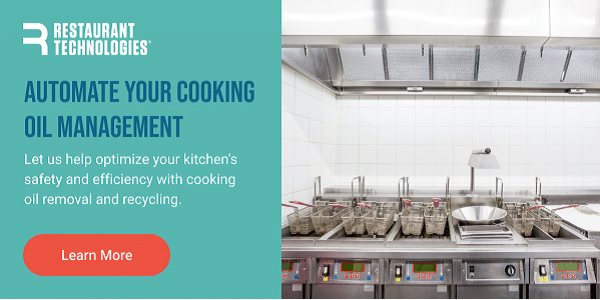
Best Oils for Deep Frying in Restaurants
Once you understand the criteria for a superb frying oil, you can order in confidence. As you shop, we recommend looking for canola, vegetable, or peanut oils.
Canola Oil
Canola oil is a golden-yellow oil made from the canola (rapeseed) plant. It has a neutral flavor and a high smoke point of 468°F, making it an all-around top choice for frying. You can also use canola oil for other cooking methods, as well as in marinades and vinaigrettes.
Canola is also one of the most affordable oils in the commercial kitchen. As of August 2023, a pound of canola oil cost $1.29 when purchased wholesale.
Vegetable Oil
Can you fry in vegetable oil? Definitely. In fact, vegetable oil is another one of the top oils for restaurant deep frying.
Before we go any further, it’s worth clarifying what vegetable oil is. When you see “vegetable oil” written on a label, you’re typically looking at a blend of stable, high-smoke point oils.
The most common ingredient in vegetable oil is soybean oil, which is mild in flavor and has a smoke point of 450°F. Other oils commonly included in a vegetable oil blend are:
- Canola oil
- Corn oil
Because vegetable oil blends vary between producers, check with your supplier for an exact smoke point. Despite variations, all vegetable oils are suitable for deep frying, as they should have a minimum smoke point of 400°F.
Vegetable oil is another of the most affordable fryer oils on the market.
Peanut Oil
Another favorite of the restaurant industry is peanut oil. With a neutral flavor and a relatively high smoke point of 450°F, peanut oil is well-suited for deep frying at any temperature.
Some restaurateurs wonder if peanut oil contains allergens for those with nut allergies. The truth is that refined peanut oil—the type commonly used in commercial deep fryers—is safe for most people with a peanut allergy. Only those with severe allergies may react to refined peanut oil. Learn more about cooking oil allergies here.
Unrefined peanut oil, on the other hand, may as well be a different product. It has a noticeable nutty taste and a lower smoke point, around 350°F. As such, it’s not an ideal fryer oil. Stick to refined peanut oil for all your deep frying needs, and use unrefined peanut oil to give certain dishes a peanut-like flavor.
Refined peanut oil may be slightly pricier than canola or vegetable oils, but it’s still an affordable choice for the commercial kitchen. Learn more about peanut oil substitutes here.
What About Other Popular Oils?
These three oils are just some of the many available options. What about other oils, like corn oil vs peanut oil or vegetable oil vs canola oil?
Can you fry in corn oil? You can—at least for a while. However, in time, the polyunsaturated fats in corn oil will break down, leading to problems with cooking and a higher concentration of oil in the finished food. Since it doesn’t last as long, corn oil is not the preferred choice for restaurants.
The same issue exists with sunflower oil, another cooking oil high in polyunsaturated fats. It may work as a fryer oil for a short time, but there’s no sense frying in something you’ll have to replace frequently. The costs of replacing your oil would add up quickly.
As for olive oil, its 350°F smoke point is too low to make it an all-purpose frying oil. Plus, it’s far too expensive to be frying in. Extra virgin olive oil is better used in dressings or as a finishing oil.
What Oil Do Commercial Kitchens Use?
Looking for more reassurance when picking a fryer oil? You may be interested to know what other restaurants are using. Here’s a rundown of oil usage in the industry.
What Kind of Cooking Oil Do Chefs Use?
Most professional chefs keep a range of oils in their kitchens for various uses. However, when it comes to frying, neutral, high-smoke point oils are the name of the game.
For Chef Jun Tanaka of The Ninth in London, UK, vegetable oil is the winner. Tanaka isn’t alone; soybean oil, the main ingredient in vegetable oil, has 70% of the restaurant market share.
That said, peanut and canola oils are also popular choices among professional chefs.
What Oil Does McDonald’s Use?
McDonald’s uses a canola-blend oil in its thousands of deep fryers across the country.
Many McDonald’s locations use Restaurant Technologies’ automated cooking oil management solutions. Our solutions allow the fast food giant to keep its oil fresh while saving time and money.
Managing Fryer Oil: Best Practices
Whether you choose vegetable, peanut, canola, or something else, there’s still the question of managing your fryer oil. To keep your food tasting its best, you need an oil management system in place.
How Often to Change Your Fryer Oil
First of all, how often should you change your fryer oil? Well, it depends on what you’re cooking.
Flour-coated foods, such as fried chicken and calamari, can release some of their coating as they cook. The flour can leave the oil looking cloudy, so you may need to change it relatively often—about every 2–3 days, depending on how frequently you fry foods.
Uncoated foods, such as potatoes, won’t dirty your oil as quickly. If you have a dedicated deep fryer for these foods, you may need to change your oil less frequently. You’ll know it’s time to change your oil if the color darkens or if your food starts tasting different.
Alternatively, you can use an oil monitoring system to detect when your oil needs to be changed. From there, you can store it in tanks until it’s ready to be picked up.
Extending Your Oil’s Life
To help your oil last longer, you can carry out a few best practices, including:
- Filtering your oil at least twice per day
- Skimming the top and sides of the fryer every 15 minutes
- Covering fryers when they’re not in use
Sustainable Practices in Fryer Oil Management
When your fryer oil finally reaches the end of its life, you’ll have to dispose of it. To do so responsibly, ensure that your oil collector recycles the spent oil. Used oil can be made into glycerin—a substance with many uses—as well as biofuel for vehicles.
At Restaurant Technologies, we pick up and responsibly recycle your spent fryer oil, ensuring none of this valuable resource goes to waste. Learn more about the benefits of recycling used cooking oil with our helpful guide.
Choosing the Best Oil and the Best Restaurant Oil Management Solution
It all starts with the oil you use. Whether you prefer canola, peanut, or vegetable oil for your deep frying needs, you can attain that perfect golden-brown crust on all your diners’ favorite foods.
However, choosing the right oil is only half the battle. It’s how you manage it that matters most for your bottom line and your impact on the environment.
With our cooking oil management solutions, you can let those decisions run on autopilot—while you focus on frying delicious foods.
From delivery to disposal and everything in between, we take care of your fryer oil needs. To find out more about this seamless service, contact our team today.
Sources:
- Heart Foundation. Which oils are safe to cook with? https://www.heartfoundation.org.nz/about-us/news/blogs/which-oils-are-safe-to-cook-with
- Canola Council of Canada. Canola Oil. https://www.canolacouncil.org/about-canola/oil/
- Toast. State of Canola Oil Prices: Wholesale Restaurant Food Cost Trends. https://pos.toasttab.com/blog/on-the-line/canola-oil-prices
- Masterclass. Cooking Oils and Smoke Points: What to Know and How to Choose the Right Cooking Oil. https://www.masterclass.com/articles/cooking-oils-and-smoke-points-what-to-know-and-how-to-choose
- Masterclass. Cooking Oils and Smoke Points: What to Know and How to Choose the Right Cooking Oil. https://www.masterclass.com/articles/cooking-oils-and-smoke-points-what-to-know-and-how-to-choose
- Bon Appétit. The Best Oils for Cooking, Grilling, Baking, and Beyond. https://www.bonappetit.com/test-kitchen/ingredients/article/types-of-cooking-oil
- Bon Appétit. The Best Oils for Cooking, Grilling, Baking, and Beyond. https://www.bonappetit.com/test-kitchen/ingredients/article/types-of-cooking-oil
- The Guardian. Which oils are best for cooking? https://www.theguardian.com/food/2022/jun/21/which-oils-are-best-for-cooking-kitchen-aide-olive-sunflower-rapeseed
- Restaurant Technologies. Cooking Oil Management 101. https://www.rti-inc.com/learning-center/oil-management-101/
- McDonald’s. Snacks & Sides FAQs. https://www.mcdonalds.com/us/en-us/faq/snacks-and-sides.html
- Restaurant Technologies. How to Make Fryer Oil Last Longer. https://www.rti-inc.com/fryer-filtration-monitoring/how-to-extend-the-life-of-your-oil
